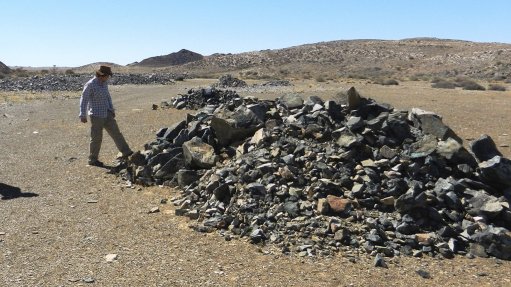
A SAMPLE OF WHAT’S TO COME Stockpile samples at the Haib copper project in Namibia are being put to the test
South African mineral research organisation Mintek has started metallurgical testwork on stockpile material from the Haib copper project, in Namibia, for Canadian rights holder and mining company Deep South Resources.
Mintek has been provided with about 1.8 t of ore sample from a large stockpile that was extracted during a previous sampling campaign. The sample contains chalcopyrite as the main copper mineral. The aim of the programme is to test the amenability of the ore to microbially assisted heap leaching. The testwork will produce data for an eventual commercial pilot heap leach campaign.
Since 2003, heap leaching technologies have evolved substantially.
For example, Chilean State-owned copper mining company Codelco has successfully used microbially assisted heap leaching of copper sulphide ore containing chalcopyrite since 2014 at its Radomiro Tomic mine, in Chile. Other operations in Chile have also piloted microbial-assisted heap leaching of chalcopyrite ores.
The testwork programme for the Haib copper project, which is located about 8 km north of the South African border, will also focus on testing the amenability of high pressure grinding rolls (HPGRs) and will test the acid consumption of the heap leaching process.
For the testwork, the bulk head sample will be crushed down to –12.5 mm with a jaw crusher. The jaw crusher product will then be subsampled and crushed with an HPGR to –5 mm, –3.35 mm and –2 mm respectively.
Subsamples from each crush size will be removed for curing acid optimisation tests and be assay-by-size sorted into four size classes, followed by geomechanical tests and column leach tests.
Additional head samples will be milled to 80%, passing 75 μm, for chemical head assay by inductively coupled plasma optical emission spectrometry and sequential copper, including acid-soluble, cyanide- soluble and residual copper.
Acid consumption tests and batch-stirred tank amenability tests will be performed on the head sample. Mineralogy will be performed on the –2 mm head sample using X-ray powder diffraction and scanning electron microscopy methods.
The column leaching test will be carried out at a temperature of 60 ºC for a total duration of 200 days. However, interim results will be available weekly.
The testwork programme is being managed by Australian engineering firm METS Engineering.
Going forward, the project will undergo 6 705 m of large core infill drilling in higher grade areas to delineate a measured resource and a potential reserve, as well as 3 400 m of deep drilling up to a depth of 800 m to add tonnage and increase the average grade of the deposit.
The drilling will also serve to upgrade the resource to measured and probable reserves to complete a prefeasibility study.
Another 10 t of samples will still be subjected to further metallurgical testing and sorting technologies testwork.